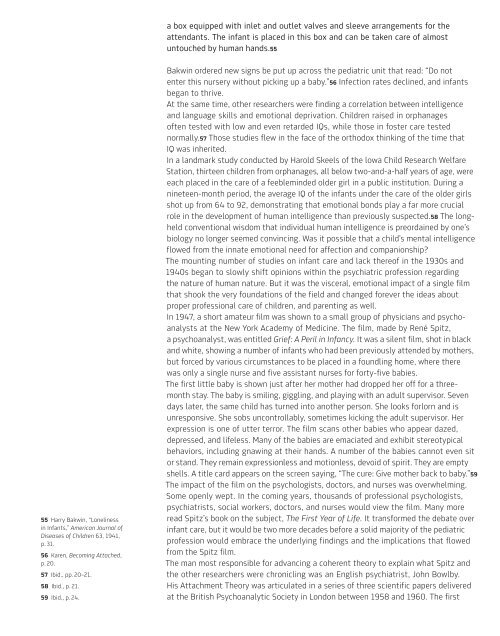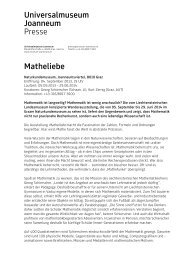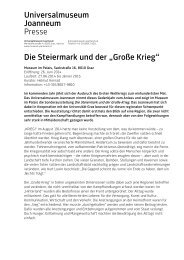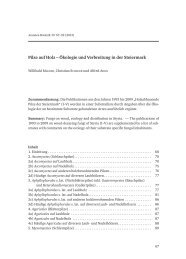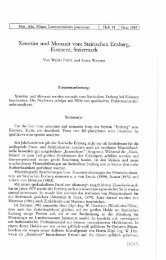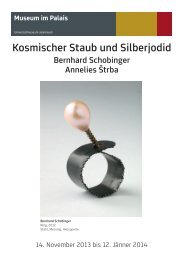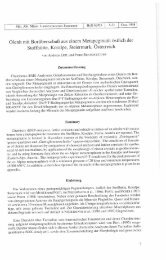Human Condition - Universalmuseum Joanneum
Human Condition - Universalmuseum Joanneum
Human Condition - Universalmuseum Joanneum
Sie wollen auch ein ePaper? Erhöhen Sie die Reichweite Ihrer Titel.
YUMPU macht aus Druck-PDFs automatisch weboptimierte ePaper, die Google liebt.
55 Harry Bakwin, “Loneliness<br />
in Infants,” American Journal of<br />
Diseases of Children 63, 1941,<br />
p. 31.<br />
56 Karen, Becoming Attached,<br />
p. 20.<br />
57 Ibid., pp. 20–21.<br />
58 Ibid., p. 21.<br />
59 Ibid., p. 24.<br />
a box equipped with inlet and outlet valves and sleeve arrangements for the<br />
attendants. The infant is placed in this box and can be taken care of almost<br />
untouched by human hands.55<br />
Bakwin ordered new signs be put up across the pediatric unit that read: “Do not<br />
enter this nursery without picking up a baby.”56 Infec tion rates declined, and infants<br />
began to thrive.<br />
At the same time, other researchers were finding a correlation between intelligence<br />
and language skills and emotional deprivation. Children raised in orphanages<br />
often tested with low and even retarded IQs, while those in foster care tested<br />
normally.57 Those studies flew in the face of the orthodox thinking of the time that<br />
IQ was inherited.<br />
In a landmark study conducted by Harold Skeels of the lowa Child Research Welfare<br />
Station, thirteen children from orphanages, all below two-and-a-half years of age, were<br />
each placed in the care of a feeble minded older girl in a public institution. During a<br />
nineteen-month period, the average IQ of the infants under the care of the older girls<br />
shot up from 64 to 92, demonstrating that emotional bonds play a far more crucial<br />
role in the development of human intelligence than previ ously suspected.58 The longheld<br />
conventional wisdom that individual human intelligence is preordained by one’s<br />
biology no longer seemed convincing. Was it possible that a child’s mental intelligence<br />
flowed from the innate emotional need for affection and companionship?<br />
The mounting number of studies on infant care and lack thereof in the 1930s and<br />
1940s began to slowly shift opinions within the psychiat ric profession regarding<br />
the nature of human nature. But it was the vis ceral, emotional impact of a single film<br />
that shook the very foundations of the field and changed forever the ideas about<br />
proper professional care of children, and parenting as weIl.<br />
In 1947, a short amateur film was shown to a small group of physi cians and psychoanalysts<br />
at the New York Academy of Medicine. The film, made by René Spitz,<br />
a psychoanalyst, was entitled Grief: A Peril in Infancy. It was a silent film, shot in black<br />
and white, showing a number of infants who had been previously attended by mothers,<br />
but forced by various circumstances to be placed in a foundling home, where there<br />
was only a single nurse and five assistant nurses for forty-five babies.<br />
The first little baby is shown just after her mother had dropped her off for a threemonth<br />
stay. The baby is smiling, giggling, and playing with an adult supervisor. Seven<br />
days later, the same child has turned into another person. She looks forlorn and is<br />
unresponsive. She sobs uncon trollably, sometimes kicking the adult supervisor. Her<br />
expression is one of utter terror. The film scans other babies who appear dazed,<br />
depressed, and lifeless. Many of the babies are emaciated and exhibit stereotypical<br />
behaviors, including gnawing at their hands. A number of the babies cannot even sit<br />
or stand. They remain expressionless and motionless, devoid of spirit. They are empty<br />
shells. A title card appears on the screen saying, “The cure: Give mother back to baby.”59<br />
The impact of the film on the psychologists, doctors, and nurses was overwhelming.<br />
Some openly wept. In the coming years, thousands of professional psychologists,<br />
psychiatrists, social workers, doctors, and nurses would view the film. Many more<br />
read Spitz’s book on the sub ject, The First Year of Life. It transformed the debate over<br />
infant care, but it would be two more decades before a solid majority of the pediatric<br />
profession would embrace the underlying findings and the implications that flowed<br />
from the Spitz film.<br />
The man most responsible for advancing a coherent theory to explain what Spitz and<br />
the other researchers were chronicling was an English psychiatrist, John Bowlby.<br />
His Attachment Theory was articulated in a series of three scientific papers delivered<br />
at the British Psychoanalytic Society in London between 1958 and 1960. The first


